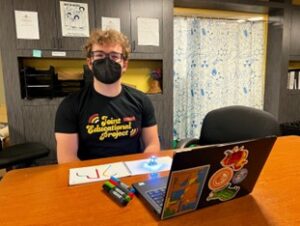 Bridging the digital divide for students with disabilities, one robot at a time
Bridging the digital divide for students with disabilities, one robot at a time
The Young Scientist Program’s (YSP) special education (SPED) section got exciting news this year (2022). YSP SPED teaching assistant Max Moulton, with the help of program director Dr. Dieuwertje Kast, wrote and received an AccessComputing minigrant from University of Washington that will fund a new computer science initiative in YSP. The grant covered the implementation of a new lab using Ozobots, programmable mini robots, to teach students in the SPED Science program how coding works in these robots and other computers. Specifically these concepts were taught in Ms. Wilt’s SDC class at Norwood Street Elementary and in Ms. Pineda’s SDC class at Vermont Avenue Elementary. In Ms. Pineda’s class, this lesson was taught via hybrid model, which means that we dropped off the robots at their school and Max taught it through zoom remotely).
Agustin Garcia demonstrating what he’s learned with his ozobot and the course he created with a thick black line.
Ozobots are programmable robots that have some unique features that make them great for teaching. Not only do they have their own easy to use coding language, Ozoblocky, but they also can be coded just by drawing! The Ozobots follow any line that is drawn on printer paper, and change their behavior depending on the color of the line. If the line is red, the LED on the robot turns red, and the same goes for any other color. Color combinations such as short lines of red then green then red, produce different behaviors such as speed up, slow down, turn around, do a little dance, and many other possibilities.
During the first half of the SPED Ozobot lab, students experimented with this color code to see how different colors can affect the behavior of the robot. They also discussed how this code relates to other languages such as human languages and the software that computers use.
During the second lesson of the Ozobot lab, students reviewed what they had learned the previous week: how to calibrate their ozobot, and then practiced using the color coding sheets from the last lesson. Once everyone was ready to move on, they began experimenting with the color code of the Ozobots’ language, such as blue-green-red to signal “nitro boost” where the Ozobot goes very fast. Many of the students noticed that when their Ozobot came from the opposite direction, red-green-blue, it did not speed up but actually slowed down significantly (called “snail dose”). The class discussed how this Ozobot “word” was asymmetrical, and thus when flipped around meant a different thing to the robot. They also explored symmetrical codes such as red-black-red which means “slow” either direction the ozobot reads it.
Abel Jimenez who is testing out various commands for the ozobot with the three types of pathways he drew.
For the final portion of the lab, students were then asked to brainstorm something for their robot to do, such as complete a maze, an obstacle course, or tell a “choose your own adventure” type story with their ozobot. Once they had their idea down, Max helped them plan out how they would do it. Would they program the turns before, or let the robot decide? How would the robot perform the task, with extra movements for fun or straightforward? Students had complete freedom to choose how they wanted to do the task, and Max helped them whenever they hit a roadblock.
One of the teachers, Veronica Wilt from Norwood Street Elementary, who watched her students experience these robots said “What I loved about this lesson was how interactive it was. The students listened, and for the most part followed directions. I have students that are non-verbal, yet they could participate and were very excited.” She went on to say that “All students wanted their own robot to keep in the classroom and pointed or talked about their maps with a smile, even after the fact.”
Max said that he heard many of his students say they wanted to be robot scientists and that these robots were their favorite STEM activity that they had done all year.